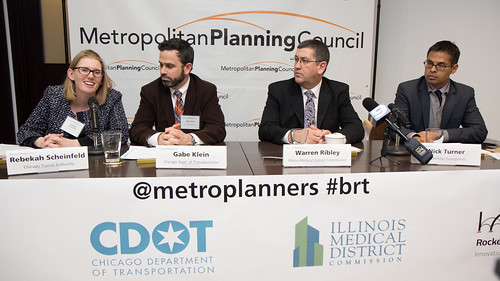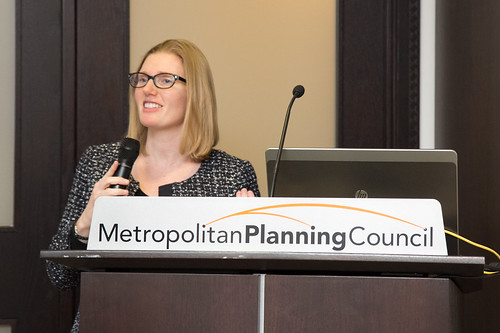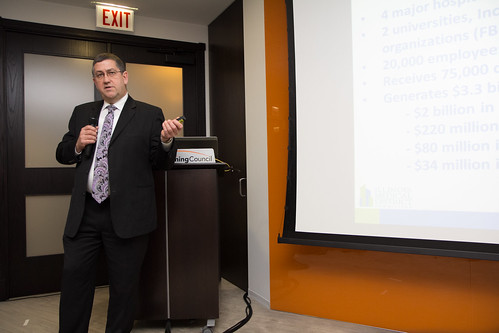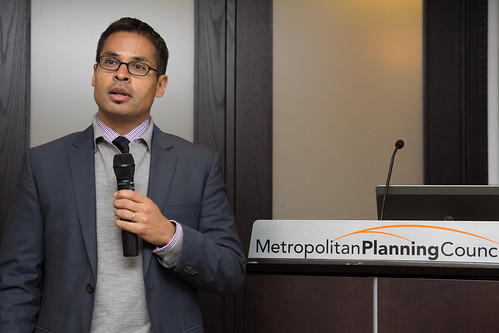“We knew how important it was for federal policy makers to see innovation and new ideas bubbling up from important cities around the country,” said Nick Turner, managing director of the Rockefeller Foundation at a bus rapid transit roundtable last Friday. The foundation has provided roughly $2.8 million in grants to Chicago's BRT program for research, technical support, land-use planning, project management, community engagement, branding and communications. “That’s why we started to get interested in the work here in Chicago.” The seminar, Bus Rapid Transit on a Roll in Chicago, took place at the Loop offices of the Metropolitan Planning Council, which promotes sustainable development and transportation in the region.
Turner heads the charitable foundation’s Promoting Equitable and Sustainable Transportation initiative. “It is not always federal policy that drives things,” he added. “It’s innovations that happen in cities that makes other mayors pick up the newspaper and they say, ‘Huh, I want that.’ We want Chicago to be able to be that for the rest of the country.”
Rebekah Scheinfeld, chief planning officer with the CTA, kicked off the discussion by talking about features that are common in BRT systems around the world, including dedicated lanes, signal prioritization, and prepaid, level boarding. She then outlined Chicago’s BRT-related projects, starting with the J14 Jeffery Jump express bus, which launched last fall on the South Side with branded buses, upgraded shelters, limited stops and bus-only lanes during rush hours between 67th and 84th.
Next she discussed plans for the Central Loop BRT Corridor, which will feature bus-only lanes on Washington, Madison, Clinton and Canal, plus level boarding, queue jumps and possibly pre-paid boarding and camera enforcement of the lanes. Scheinfeld closed by outlining the proposal to create BRT routes on 21-mile corridors along Western and/or Ashland, which would be within walking distance of one out of four Chicagoans. The CTA estimates that faster bus service on these routes could save the average commuter 50-65 hours each year, the equivalent of $650-850 per year, she said.
Commissioner Gabe Klein from the Chicago Department of Transportation went into further detail about the downtown BRT plans. “This is really a balanced, complete street approach to BRT,” he said, noting that the proposed street configurations include dedicated bus, car and protected bike lanes, as well as pedestrian improvements. The project is currently at the 30 percent design phase; the design work should be finalized by the end of the year, and construction completed by the end of 2014."
The plan also calls for a new transit center to be built on what’s currently a surface parking lot just south of Union Station. The city is currently working on acquiring the land. “Yes there’s some parking going away but there’s a huge garage with a lot of capacity going in next door, and to be honest we have a lot of capacity for parking throughout the loop,” he said. Klein added that the new facility will have three lanes and nine bus bays serving five routes, plus access to an underground pedway leading to the train station. As he showed renderings of the somewhat drab-looking facility Klein said, “We haven’t added the public art yet so it’s a little gray right now, but it will be beautiful, I promise.”
Warren Ribley, executive director of the Illinois Medical District Commission, said that BRT corridors on Western and Ashland would be a boon for employees, patients and students who commute to the 560-acre medical complex. “The hospitals all have parking decks and they’re all full,” he said “If you drive along Harrison and Congress on any given day you can’t find a parking spot. Public transportation is critical to the growth of the medical district.”
He noted that that many surface parking lots within the district are slated for development in the next few years. “So we’re going to have to pay attention to how we get people into the medical district and back out. We can’t just do it by building more parking. That is why proposals like BRT are so important to us.” He noted that some 20,000 workers and 75,000 visitors commute to the district each day. Ten percent of those trips are currently done on transit, and that number is steadily rising. “From a selfish perspective we’d really love to see BRT on Ashland since it’s our eastern boundary and that’s really where the access to all the medical facilities are at,” he added.
Nick Turner discussed Rockefeller’s $75 million, seven-year initiative to advance equitable and sustainable transportation, with the goals of strengthening cities, reducing transportation costs for millions of Amercans, and decreasing pollution. “We thought, wouldn’t it be great if there were a few cities that could move forward and advance [BRT"] projects of the kind that one sees in Bogota or Mexico City,” he said. The foundation has endorsed the Institute for Transportation and Development Policy’s “BRT Standard” guidelines, which rate systems around the world as gold, silver and bronze, similar to the LEED green building guidelines.
Turner noted that while express bus systems in Cleveland, Los Angeles, Las Vegas, Eugene and Pittsburgh have been rated bronze by the ITDP, no US city has achieved a silver or gold rating. Rockefeller hopes Chicago will boldly implement its upcoming BRT projects, setting a new bar for stateside public transportation. “We hear a lot about Chicago being a global city,” he said. “Here’s your chance to really show other cities what can be done with bus rapid transit.”








